|
Michael McFadyen's Scuba Diving - The Monuments
On 29 April 1770, Lieutenant James Cook, RN, in HM Bark Endeavour entered Botany Bay and stepped ashore at Kurnell. Cook and his crew, including the famous scientist Sir Joseph Banks and his assistant Daniel Solander, explored the area of the bay and originally named it Stingray Harbour because of the large number of rays they caught. Cook stayed eight days and then headed north.
Both headlands of Botany Bay are part of Botany Bay National Park. The southern side is known as the Captain Cooks Landing Place section of the national park and is accessed from Captain Cook Drive at Kurnell. A fee is charged to use the park's facilities. NOTE: the park is closed at night, so night dives are not possible.
After entering the park, travel along the main park road and take the turn-off to the visitor centre and Sutherland Point (named by Cook after one of his seamen, Forby Sutherland, who is buried nearby). Once past the visitor centre, you will see a formed parking area on your left. The carpark is clearly marked as The Monuments Car Park (not Sutherland Point or Inscription Point) The spots go quickly on fine weather days so make sure you get there early, especially in summer.
 | 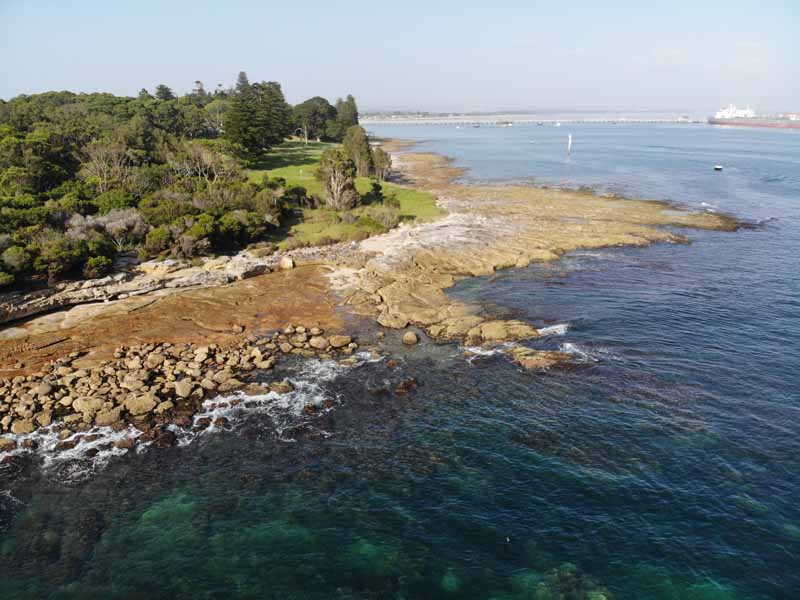 |  |
The Monuments dive site from my drone
Click to enlarge | The entry point is the inlet in middle
Click to enlarge | The exit is anywhere along here below the sand
Click to enlarge |
The dive site is named after the monument that is located overlooking the water and which has a flagpole that is very obvious as you walk to the water's edge. Note that since about 1997 some people have started referring to this dive site as Inscription Point or even Suterland Point, but it has traditionally been known as The Monuments. Inscription Point is legally the point to the east of this site and the dive site called Inscription Point is further along the main road past where you turn off to come here.
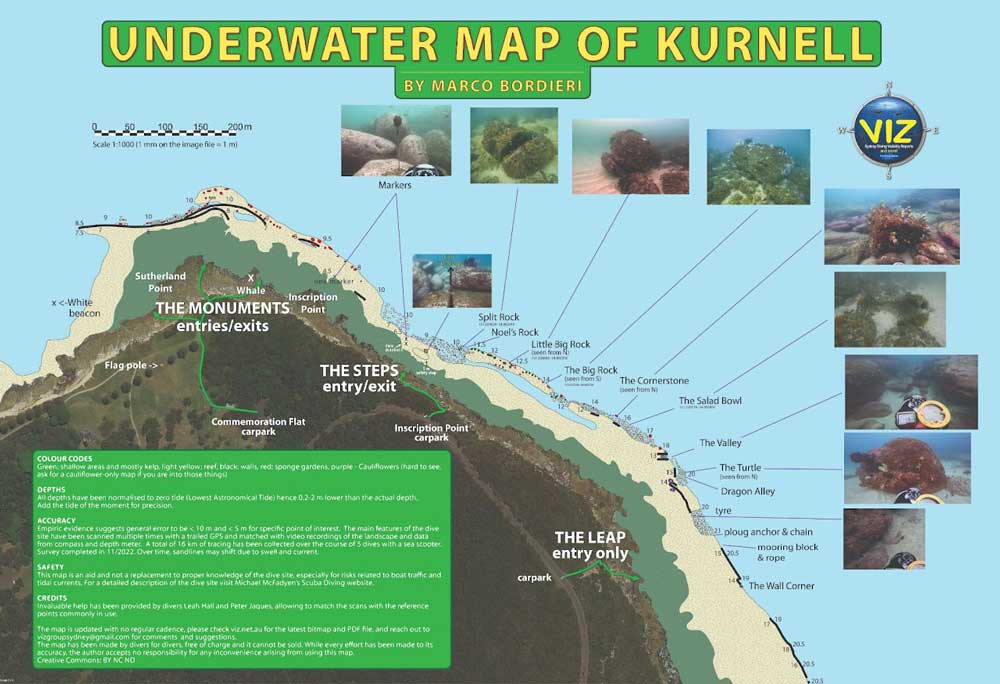 |
A new underwater map of Kurnell created by Marco Bordieri from www.viz.net.au.
For a much larger pdf version of this map, click here.
Used with permission of Marco Bordieri |
DIVE ONE
There are two dives you can do here. This one is a drift dive from Inscription Point to The Monuments. This dive can only be done on an incoming tide (it does not matter what time of the tide you do this dive or how high the tides may be). After entering the park, travel along the main park road towards Cape Solander and past the turn-offs to the visitor centre and Sutherland Point (named by Cook after one of his seamen, Forby Sutherland, who is buried nearby).
Park in one of the spots and walk across the grass, keeping the bush just on your right. Follow this to the rock platform and you will see a very large bronze humpback whale sculpture. This was put there in April 2020 when the Federal Government gave a ridiculous amount of money to the national park to help celebrate the 250th anniversary of Cook's arrival here. Most of the money was wasted and they only got it because Scott Morrison was PM and the local Member for Cook. At least the whale and the other sculptures are worthwhile additions to the park.
Anyway, behind this is a small point of rock and to the right a small inlet. This is the entry point (and can be the exit if you want for Dive Two). If the seas are okay, go back and gear up. Return to the entry point.
An alternate entry point is about 75 metres to the east on some flat rocks.
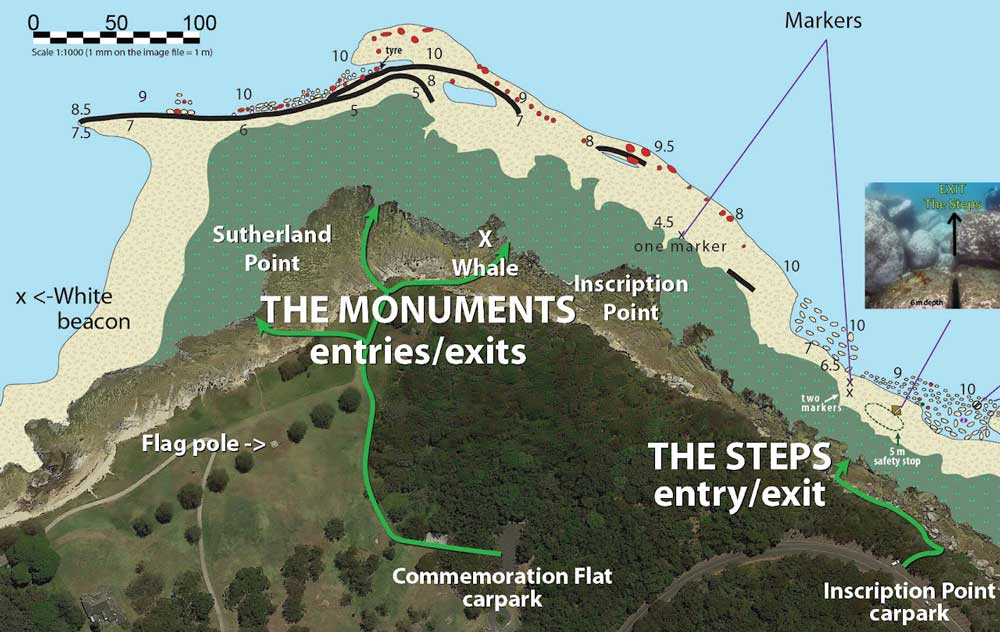 |
A more detailed section of Inscription Point to Monuments dive site created by Marco Bordieri from www.viz.net.au.
For a much larger pdf version of this map, click here.
Used with permission of Marco Bordieri |
If there is a little swell, you will need to take care in entering the water. Swim out 10 or 15 metres and descend. Head north or north-north-west till you strike the sand edge. This will take you two minutes. You will drop over a decent wall and the depth is about 12 metres. Off the wall there are some small boulders and large rocks. These have very nice sponges, sea tulips and small gorgonias. Some have kelp on them and there is a lot of kelp on the rocks between the boulders. Head west and the wall goes basically exactly west.
When looking at the sponge covered rocks, have a close look and you will see numerous nudibranches of many species. The rocks are also home to numerous other species of animal, including giant jelly, magnificent and blue throated ascidians, lace coral, sea fans, tube worms and sea squirts. Many of the rocks are covered with a redish weed. If you look very carefully at this weed, you may find that you will see a pygmy pipehorses. They are very hard to find, so it may take you a long time (as it did for me).
On the sand off the wall and near the boulders you should see common sea dragons. They can often be found in the small "bays" of sand on the reef edge and in between the larger boulders. These fragile looking fish move around ever so slowly. In the late winter and early spring period look close and you might see a "pregnant" male.
On 3 June 2006 I saw about eight sea dragons, including one small sea dragon, on this dive. On 19 October 2006 I saw nine sea dragons, of which seven were pregnant males.
 | 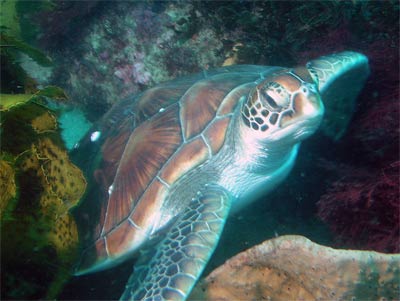 |
| The Monuments - entry and exit points are labelled | A hawksbill turtle that we saw near here in February 2006 |
Jaime Sanchez Camara from Spain carried out a study of sea dragons at Inscription Point and The Monuments. In 2000 he tagged 90 sea dragons at this location with minute coloured tags placed under their skin and visible with a "blue light" (ultraviolet). Since then he has been coming back regularly and noting the numbers of sea dragons that he has refound. It was previously believed that that their movement was limited to about 100 metres. Until December 2004 when I took Jaime on a dive at Bare Island Isolated Reefs on the other side of Botany Bay, none of these 90 sea dragons had been seen outside the originally tagged location. However, on that dive, we found one of the tagged sea dragons, over 1.3 kilometres from Inscription Point. This is a first, showing that sea dragons may move long distances.
However, in more recent years there has been far less sea dragons seen, I think because of many periods of dredging for the port expansion, an electricity cable and a water pipe as well as huge rainfall in early and mid-2022.
We have seen many interesting things while diving at this site and Inscription Point. I have seen a shark which at the time we had no idea what species it might be (I now believe it to be a very very skinny grey nurse shark) and since then grey nurse sharks a few times. I have seen turtles a few times. In June 2006 we saw a medium sized hawksbill turtle (see the photo above which is a different one I saw in February 2006 at Inscription Point) just off the wall.
In the period after 2015 we have been seeing Bare Island anglerfish here as well as sometimes painted anglerfish.
As you travel to the west, the depth varies between 12 and 14 metres and the wall's height varies from one metre to about three metres. If you move very slowly, once you get to the three metre wall, you can turn around and head back to the entry point.
If you are doing a one-way drift dive, after about 30 or so minutes the wall peters out and you will have sand on your left. Head south and after a minute or so you will encounter another wall. The depth is now 12 metres and there is an even more prominent wall. This wall is a consistent three metres high and has lots of overhangs. The depth will gradually come up to 10 metres as you follow this section of wall.
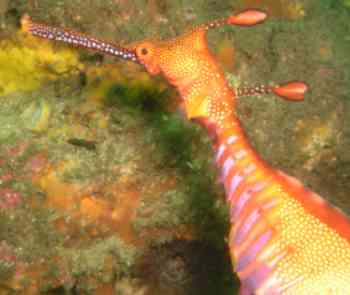 | 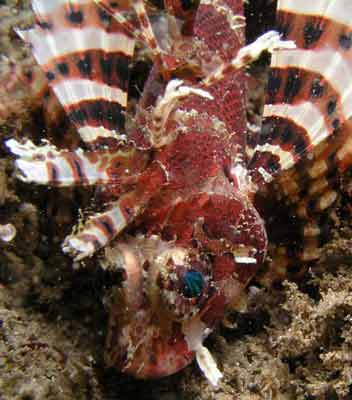 |
| A close up of a common sea dragon | A dwarf firefish at The Monuments |
This wall is quite amazing. As I mentioned, there are lots of overhangs. Some of these are so large I would call them caves. You will see things like large cuttlefish and schooling catfish in them. After 40 to 45 minutes this wall also disappears. If you wish to finish the dive you can head south and in 9 or 10 minutes you will reach the shore. There are lots of easy exit points here and it is a simple matter to find one.
Alternatively you can keep heading in a rough westerly direction for another five minutes before heading to the south-east. This will bring you into a small sand gutter that leads back to the shore. Again, another alternative is to keep heading south-westerly from this area across the sandy bottom. There is a lot of sea grass here and some interesting things can be seen, including small cuttlefish, large flathead, nudibranchs, sea hares, pipefish and more. Eventually you will pass by (probably) the channel marker and then end up on the beach to the west of Cook's water point.
DIVE TWO
The second dive here is normally done right on high tide or on incoming or outgoing tides where there is very little change in water heights. You start at the same place as the Dive One, so follow those directions and then again head north-north-east. As you drop over from the shallower section towards the sand, take note of a prominent feature so you know where to start your trip to the exit. I use a boulder that has some very obvious white sponges.
Once you hit the sand, you turn right and go east for about 15 to 20 minutes, depending on your air consumption and the current. On this dive at first there is a small wall which is interesting and there are some large boulders off it. Sea dragons are normally more common on this dive than the above dive. After the wall ends, there are more smaller boulders. The sponge life is also very good here. Look for Bare Island anglerfish and pygmy pipehorses. The depth on the sand is about 12 to 13 metres.
Once you turn around, slowly head west. Back near where you first met the sand, the reef consists of smaller boulders. I normally stay near the sand as I go along. The depth is also about 12 to 13 metres. After about 40 or 50 minutes, turn again and head back to the east. This time come along the reef a bit shallower. This section has the spots where I have mostly seen Bare Island anglerfish as well as painted anglerfish.
When you spot the feature that you noted at the start of the dive, head back to the south-south-west. Stop on the top of the wall for a safety stop if you want and then continue in the same direction. It can be hard to find the actual exit spot, so you probably may need to surface from a few metres to check.
Apart from common sea dragons, other fish to be seen here are common stingrays, flatheads, leatherjackets of all sorts (especially pygmy leatherjackets), bream, moray eels, small cuttlefish, old wife, bream, luderick, sergeant baker, blue groper and different types of wrasse.
Visibility here is usually never great, with five to seven metres being considered especially good, although I have had as much as 20 metres a number of times. Tides are not really a consideration as they never really get strong enough to affect a dive plan. However, you will get marginally better visibility on an incoming tide and will also be travelling with the tide for the whole dive.
The Monuments is a very good dive site. It is especially good in very strong southerly winds and seas as it is one of the few sites protected in Sydney. Even in very large southerly/south-easterly swells you can normally dive here. If the seas are from the north to east quarter and are big (over 1 to 1.5 metres) then you may have problems.
After the dive you can have a barbecue on the free gas barbecues or a picnic lunch. It is also a great place to make a day of it with two dives and a good surface interval
This dive also makes a great night dive. However, as you cannot access the park at night time (the gates get locked at various times over the year), you need to do it a little differently. Park at the corner of Captain Cook Drive and Prince Charles Parade. Gear up and walk along the formed pathway to the north-east (parallel to the shore). After about 400 metres you will see a monumental seat inscribed "Banks". Stop here for a rest. Then keep going along the path till it turns back inland and then follow the grass close to the edge of the shore. Head to the normal entry point. This is about 800 metres from the spot where you parked your car. It is a long walk but not too hard as it is flat. Exit as the last option above (just before the Banks seat). A really great dive worth the effort.
MORE PHOTOS
I have a whole page of photographs which came from three dives over three days in April 2020. Click here to see them.
 | 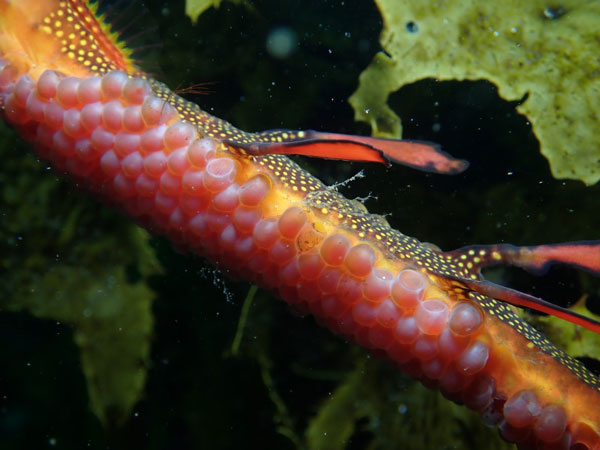 |
| A close up of a common sea dragon | Male sea dragon with eggs |
 |  |
| Blue-lined bubble | Made-up phyllodesmium, aka opera house nudi | 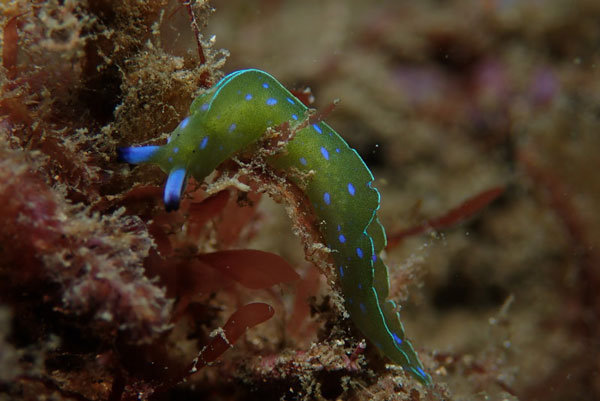 |  |
| Blue spotted elysia | Bennetts hypselodoris |
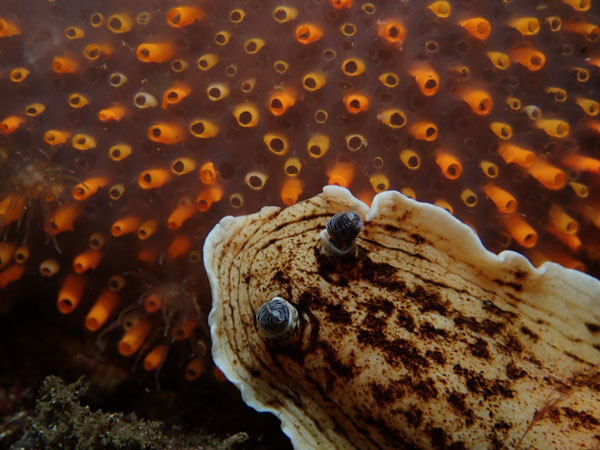 |  |
| Variable apheldoris on a giant jelly ascidian | Purple-lined nembrotha |
| 
 v6.00.307 © 2003-2005
v6.00.307 © 2003-2005